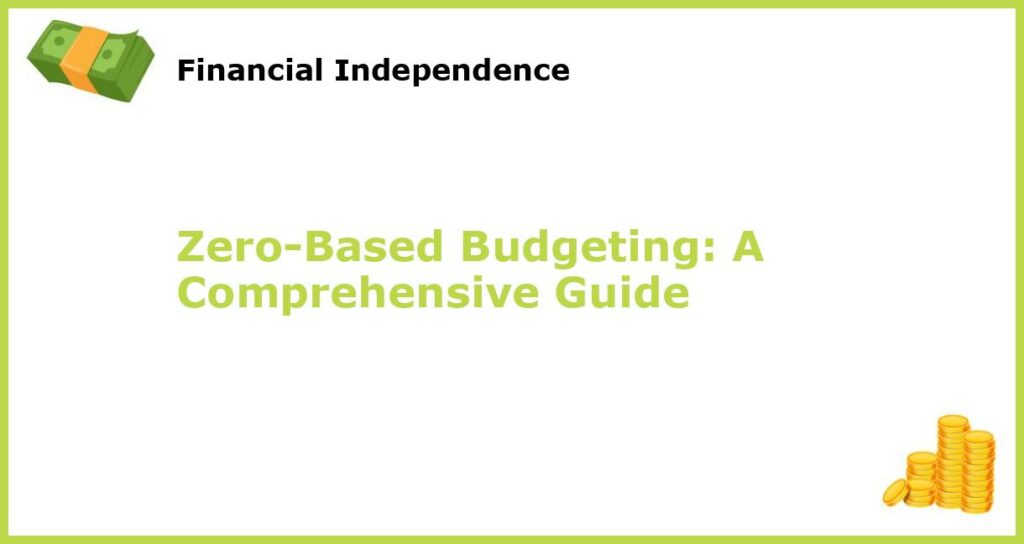Welcome to the comprehensive guide on zero-based budgeting! You may have heard about this budgeting technique before, but do you really know what it is, how it works, and why it’s important for businesses? In this guide, we will answer these and other questions, and provide you with useful tips and insights to help you implement zero-based budgeting successfully. Let’s begin!
What is zero-based budgeting?

Zero-based budgeting is not just another buzzword in the business world, but a powerful tool that can help businesses achieve better financial efficiency, transparency, and control. Put simply, zero-budgeting is a budgeting technique that involves starting from scratch for each new period, rather than relying on the previous period’s budget as a starting point. Under this approach, managers must justify all expenses as if they are new, requiring them to scrutinize and re-evaluate all spending categories with the aim of ensuring that each expense aligns with the company’s strategic goals and objectives.
This means that regardless of whether the budget has increased or decreased compared to the prior period, the business must justify why the money is needed to support specific activities that align with the company’s priorities. By following this approach, businesses can get a clear understanding of where the money is going, what the priorities are, and if the expenditures align with those priorities. Essentially, with zero-based budgeting, every aspect of the business must earn its place within the budget, based on its importance to the organization’s goals.
Why is zero-based budgeting important?

Zero-based budgeting is critical for businesses that want to ensure the right amount of resources are allocated to the right activities to support the organization’s strategic goals. This approach requires a more comprehensive analysis of each expense category, giving businesses a better understanding of how their resources are being used and whether they are being used efficiently to drive value to the organization.
Additionally, by examining individual expenses closely, zero-based budgeting helps to uncover hidden inefficiencies and identify areas of improvement. It also aids in motivating employees to focus on creating value within the organization while tracking and measuring the resources used to achieve these objectives. Overall, it provides clarity, control, and efficiency by hugely aligning the company’s financial resources with its goals.
What are the advantages of zero-based budgeting?

The zero-based budgeting technique has many advantages, some of which include:
- Uncovering inefficiencies: The process helps to identify and remove costly, low-value activities and allows for the allocation of resources to high-value, strategic activities.
- Promoting accountability: Zero-based budgeting requires managers to justify their spending, which ultimately fosters responsibility and accountability throughout the organization.
- Aligning resources: This approach ties resources to company objectives, ensuring business operations are aligned with the strategy and priorities of the company.
- Encouraging value creation: With zero-based budgeting, departments must justify every expense applied to their functions, which helps them focus on activities that create more value for the company.
How does zero-based budgeting differ from traditional budgeting?

The traditional budgeting approach starts with the previous period’s budget as its starting point and then updates it based on revenue forecasts or inflation. This means an organization’s executives tend to fell back on previous year results, stastically adjusted for revenue growth or inflation to generate their budgets. The zero-based budgeting process works differently, starting from scratch every time. It involves different steps where managers are required to assess each item of expenditure before identifying which ones they need to include in the new budget.
The key difference between the two is that zero-based budgeting begins from ground zero and looks at each expense category with a critical eye, while the traditional budgeting approach merely subtracts or adds funds based on prior years’ results. As a result, zero-based budgeting is more flexible in adapting to changing conditions, while traditional budgeting can result in conservative thinking and inefficient allocation of resources.
What are some common misconceptions about zero-based budgeting?

One of the prevailing misunderstandings of the zero-based budgeting approach is it is merely a one-off exercise. That zero-based budgeting is a process that will run out after one session is a misconception. It is a dynamic, ongoing approach that requires regular fine-tuning and adjustment from management. Secondly, implementing zero-based budgeting is not a silver bullet solution to financial management issues. It can take significant financial resources and time to get the approach right for an organization.
What are the steps in the zero-based budgeting process?

According to many industry experts, the zero-based budgeting process includes:
- Establishing objectives and business requirements: This step defines the company’s financial goals and priorities.
- Indentifying the various activities: The management team, in union with the department heads, must provide a detailed list of various activities needed to achieve the company’s objectives and how they can drive value.
- Calculating the cost of each activity: Specific assessment of each activity in the light of the money that will be required to pull them off, including infrastructure and personnel, must be calculated.
- Re-prioritising the packages: After calculating the packages and importance to the business are evaluated, they are assessed against actual business priorities and goals, and then decisions can be made regarding which activity to focus on.
- Allocating available funds: Budgetary funds are allocated to high-value activities that are critical to fulfilling the company objectives.
- Monitoring and adjusting the budget: Regular fine-tuning of the budget needs to be carried out throughout the period so that a business can remain on track to achieve its objectives.
What are some common challenges in implementing zero-based budgeting?

The implementation of zero-based budgeting can face its fair share of challenges, primarily due to pre-existing budgeting practices. Resistance to change and a cultural shift towards financial management can hamper its adoption. Another common challenge is deciding on the level of detail needed when implementing zero-base budgeting which could be done by determining if the organization should use highly structured computerized software or use manual systems like Microsoft Excel spreadsheets to complete the approach.
Who can benefit from zero-based budgeting?

Any organization, regardless of size or the sector it operates in, can benefit from zero-based budgeting. This approach is great for businesses that need to adapt quickly to changing market conditions or are in high-growth cycles. Companies looking to obtain more significant control over resource management, create more transparency in their spending, and target cost reduction efforts more strategically can benefit from zero-based budgeting.
What tools and technologies can be used to implement zero-based budgeting?
Implementing automation technology such as Enterprise Management Solutions (EMS) can streamline the zero-based budgeting process. Tools like EMS provide an end-to-end solution that delivers an efficient and faster process for the zero-based budgeting method. However, for many small businesses, these systems’ costs may be prohibitive, and they may be better served by sticking with spreadsheets and other manual approaches.
What are the potential downsides of zero-based budgeting?
There aren’t too many downsides to zero-based budgeting, but the most common one comes from its implementation cost. The cost of time and resources in establishing an effective zero-based budgeting system and process can be significant. Secondly, it requires significant attention to detail, which means it can be time-consuming in the initial stages while the company transitions to this method. Overall, the benefits of zero-based budgeting far outweigh these downsides.







